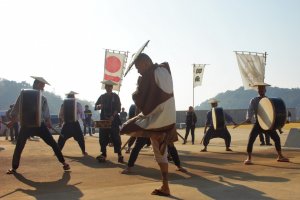The Seto Inland Sea is full of isolated islands surrounded by the seascape which have maintained their own, distinct culture. Teshima and Naoshima Islands are two such islands, integrally connected with art and culture in the form of festivals, museums and sporadically placed statues and structures. Despite all of the artwork and museums that have made these islands famous, they retain their natural beauty, and visitors are constantly surrounded by lush greenery.
Both of these islands take part in the multi-island international art festival called the Setouchi Triennale (瀬戸内国際芸術祭) every three years. The 2016 festival had twelve participating islands and took place for two-month periods in spring, summer, and fall. Naoshima and Teshima have both hosted several exhibitions and installations during these festivals and also have permanent museums and installations available year round.
Naoshima Island
Naoshima is very deserving of its nickname, “Art Island.” The most famous museum on the island is the Chichu Museum which was designed by Tadao Ando. This museum houses the works of Claude Monet, James Turrell, and Walter De Maria. Very nearby is the Benesse House and Benesse Museum. The Benesse Museum is filled with art pieces from a wide range of styles, and the grounds contain numerous outdoor sculptures places on the green hillsides by the sea.
Two of the most iconic art installations on Naoshima are outdoor sculptures of polka-dotted pumpkins made by Yayoi Kusama. One, the larger red one, is located at Miyaura port. People are always seen in and around this famous piece. The small yellow-orange one is located on the other side of the island on a deck below the hills that house the Benesse grounds. Another permanent installation on Naoshima is the Art House Project. The Art House Project is comprised of a series of locations, mostly old houses, with different artists contributing to installations incorporating these old spaces.
Teshima Island
Teshima is a much more secluded island to the east of Naoshima. Its setting is more isolated and the natural beauty is stunning. The feeling of remoteness enhances its rustic charm. The Teshima Art Museum is the main attraction year-round. It is located in the corner of a rice terrace overlooking the sea. The museum is a building designed by artist Rei Naito and architect Ryue Nishizawa in the shape of a water droplet. The building has two ovular openings which let in natural light, the sounds of wind and birds, and the green of the forest. The sloped floors are covered in holes where water comes through. This water moves water across the floor of the building in a way that is almost magical.
Both islands have seen an uptick in visitors over the last decade and a few shops and cafes have opened up nearby the ports. They are all worth trying and really add to the local experience.
Teshima and Naoshima lie between Kagawa Prefecture on Shikoku Island and Okayama Prefecture on the main island of Honshu. They can be accessed from either of these two prefectures by boat.
































